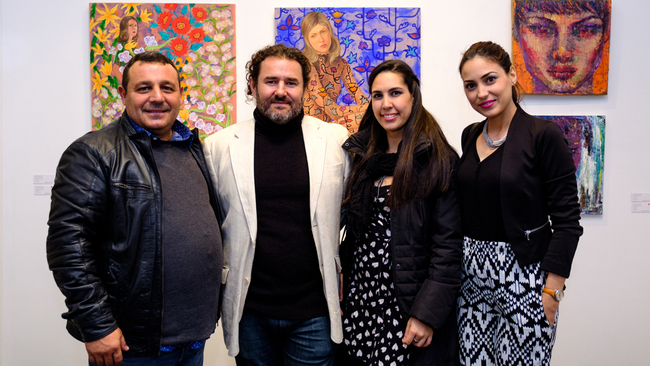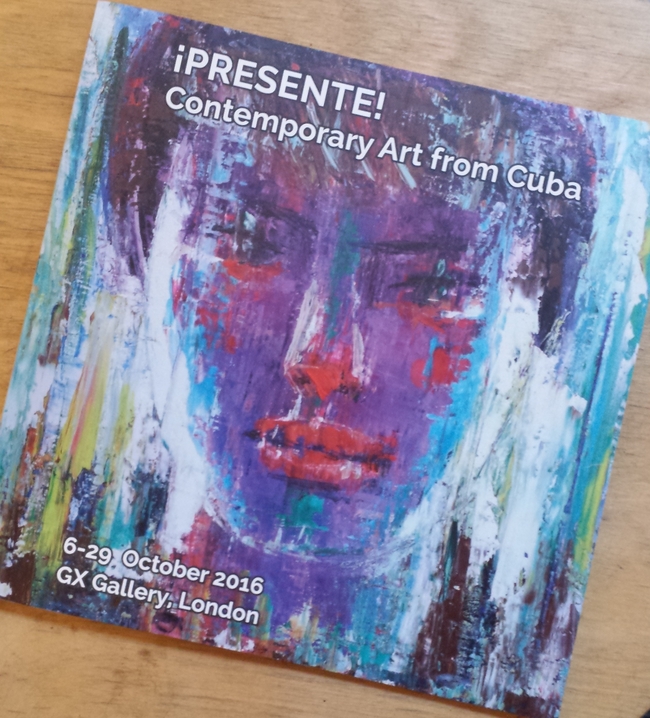¡Presente! Contemporary Art from Cuba on at the GX Gallery until 29 October
MFFC news
| credit:
by Natasha Hickman
on: Thursday, 20 October 2016

¡Presente! Contemporary Art from Cuba on at the GX Gallery until 29 October
The Presente! exhibition finally opened its doors for the month of October at GX Gallery in Denmark Hill, London.
It had been planned for 18 months, in conjunction with the Cuban Ministry of Culture and the Fondo Cubano de Bienes Culturales plus GX Gallery, with the aim of introducing a British audience to the visual arts of Cuba while raising funds for arts materials for young people on the island.
As well as putting on the exhibition, for 12 days, three Cuban artists and a Cuban curator were invited to the UK by Music Fund for Cuba to speak to people in many different venues, talking about their art and Cuban culture. They were: artists Adislen Reyes, Luis Camejo and Mario Gonzalez, with Chrislie Perez Perez, Cuban curator.
Adislen Reyes is a young artist, who makes exquisite prints, using drawing, paint and collage, which are witty and serious at the same time, asking questions about her own identity and that of her contemporaries and the relationships between the individual and the collective, the artist and her art.
Luis Camejo is an established artist who captures cinematic moments in paint and whose special focus is as he says the city as a human jungle, almost with an identity of its own. He is famous for painting many images of the Malecón, Havana’s famous seawall, which he walks along every morning.
Mario Gonzalez is a member of artist trio ‘The Merger’. Internationally very successful, splitting their production between Havana and Miami, they make strange large steel sculptures and many drawings and screenprints while they explore ideas for sculptures - inspired by the relationship between machines and human beings.
Chrislie Perez Perez is a curator and art specialist at a Havana gallery, run by the Ministry of Culture. She studied art history and is committed to helping others appreciate art, with a slot on Cuban TV talking about art.
The exhibition was opened to a packed VIP Private View where over 100 special guests enjoyed meeting the artists while viewing the works for the first time. Rob Miller, opened the exhibition on behalf of the Music Fund for Cuba and speakers included HE Teresita Vicente, Cuban Ambassador, Dodie Weppler, one of the coordinators of the show and Anand Sagar, owner of the GX Gallery.
Following the opening night the artists took part in a programme of events around the country. By the end of the tour the Cubans had had some fascinating exchanges with many hundreds of people interested to know about their art and culture and as Chrislie summed up: “Culture in our country is not longing for the past but stands confidently in the here and now.”
How to see the art
You can visit the show at the GX Gallery until 29 October 2016.
GX Gallery, 43 Denmark Hill, London SE5 8RS
Opening hours: Mon/Tue/Wed/Sat 9.30am-6.00pm Thu/Fri 9.30am-7.00pm Closed on Sundays
After this date you can see a smaller selection of the works on show at Searcy’s Club, St Mary’s Axe (The Gherkin) in central London from 7 November to 22 December. Visiting there is strictly by appointment only via the GX Gallery. Call 020 7703 8396 or info@gxgallery.com
How to buy the art:
Contact the GX Gallery www.gxgallery.com T: 020 7703 8396
 Buy the catalogue
Buy the catalogue
60 pages, full colour with beautiful images of all the works plus biographies and other information. Buy the catalogue from CSC online shop.
Education pack
There is an online Education pack accompanying the show with ideas for art projects for young people based on some of the works in the show – download from the website at www.presentecubanart.org/education If you are a teacher and would like to use it with your students do please get in touch atpresentecubanart@gmail.com
Art materials appeal
While the US blockade against Cuba persists, arts education continues to suffer from lack of materials and opportunities for exchange. Surplus from the sale of artworks in this exhibition will go towards art materials for young people in Cuba, but you can also donate directly for these materials to a special fund via the Music Fund for Cuba JustGiving page.
Find out more about the project at www.presentecubanart.org
Background to the exhibition and about the Art
Today Cuba is in the midst of an artistic boom. Some have even suggested that the island is in a state of ‘artistic overproduction’. At the Havana Art Biennial in May 2015, visitors were overwhelmed by the incredibly diverse, complex, sometimes provocative, and often humorous art work. For a month Havana was awash with art - inside galleries, and in every imaginable space outside.
This boom has been brewing for some time. It has been stepped up with the easing of restrictions on US travel to Cuba as collectors flock to the island. But the abundance of artists on the island can be explained above all by the central role given to the humanistic values of culture since the fundamental economic and social transformation began in 1959. As Cuban curator Chrislie Perez has said: “Art is a human right in Cuba”. This made possible a world class cross-discipline art education system, free to anyone with talent, beginning in secondary school and continuing to post-graduate level. This formal system is accompanied by local community art centres enabling everyone to join in some cultural activity, plus many national institutions which have helped shape attitudes to culture and maintain the ever changing debate. The path of encouraging people to be artists who can create whatever they want as long as they do it well, has not been an easy one, but it has paid off.
The PRESENTE! exhibition has celebrated this stupendous artistic achievement. It announces that Cuban art has arrived. It is unique for two reasons. First, it has been the biggest show in the UK for years with over 30 Cuban artists; and secondly, it has brought together different generations, where artists in their twenties are exhibiting alongside others who have been creating art for six decades. Despite the diversity in themes, genres, styles and artistic languages, the common thread is to reflect concerns within current Cuban society while acknowledging international art scene ideas.
Amongst the younger generation figurative painting and pop art loom large - large formats, a bright palate, and references from fashion, the street, domestic spaces and advertising icons, such as Harold Lopez Muñoz. In the work of Adislen Reyes, Lisandra Garcia and Osy Milián - and numerous women are in the forefront of newly emerging talent - the image of the female body is instrumental in interrogating issues relating to gender and young womanhood, but with a quirky, personal stamp - they are not didactic. In his 40s, Reynerio Tamayo’s work shines with his huge range of references and is always up for a laugh, with an incisive punch. Satirical humour is his bridge for opening up a debate, not just about Cuba’s relationship with the US but also about the artist’s relationship with the art world and the role of the artist.
Social concerns permeate works of older artists. René Peña brilliantly uses photography to construct images of the black male body alongside a variety of heavily coded objects which challenge the stereotypical gaze. Eduardo Roca, known as Choco, uses collography to make visible the internal world of his Afro-Cuban characters, referencing elements of santeria, the syncretic religion born in Cuba with its roots in West Africa, which permeates all of Cuban culture, regardless of religious belief. Kcho’s drawings of people and parts of boats bring to mind the current crisis of migration of people on a global scale. As islanders, it is not surprising that the sea often features as a central element. Luís Camejo skilfully captures the meeting point as the mighty waves of the sea encroach on the city in his cinematic meditations in oils and watercolour on the Malecón.
Niels Reyes is more concerned with the fragile psychology of the individual and invites us to consider the reality beneath the surface of his highly textured human faces. One of the youngest artists in the show, Richard Somonte, paints landscapes, almost pastiches, to join an art historical dialogue paradoxically critiquing current ‘anti-art’ trends. Pedro de Oráa, the oldest artist in the show and the only living member of an influential group of ten geometric abstract artists in the 1950s, today works from initial drawings which he then manipulates digitally.
